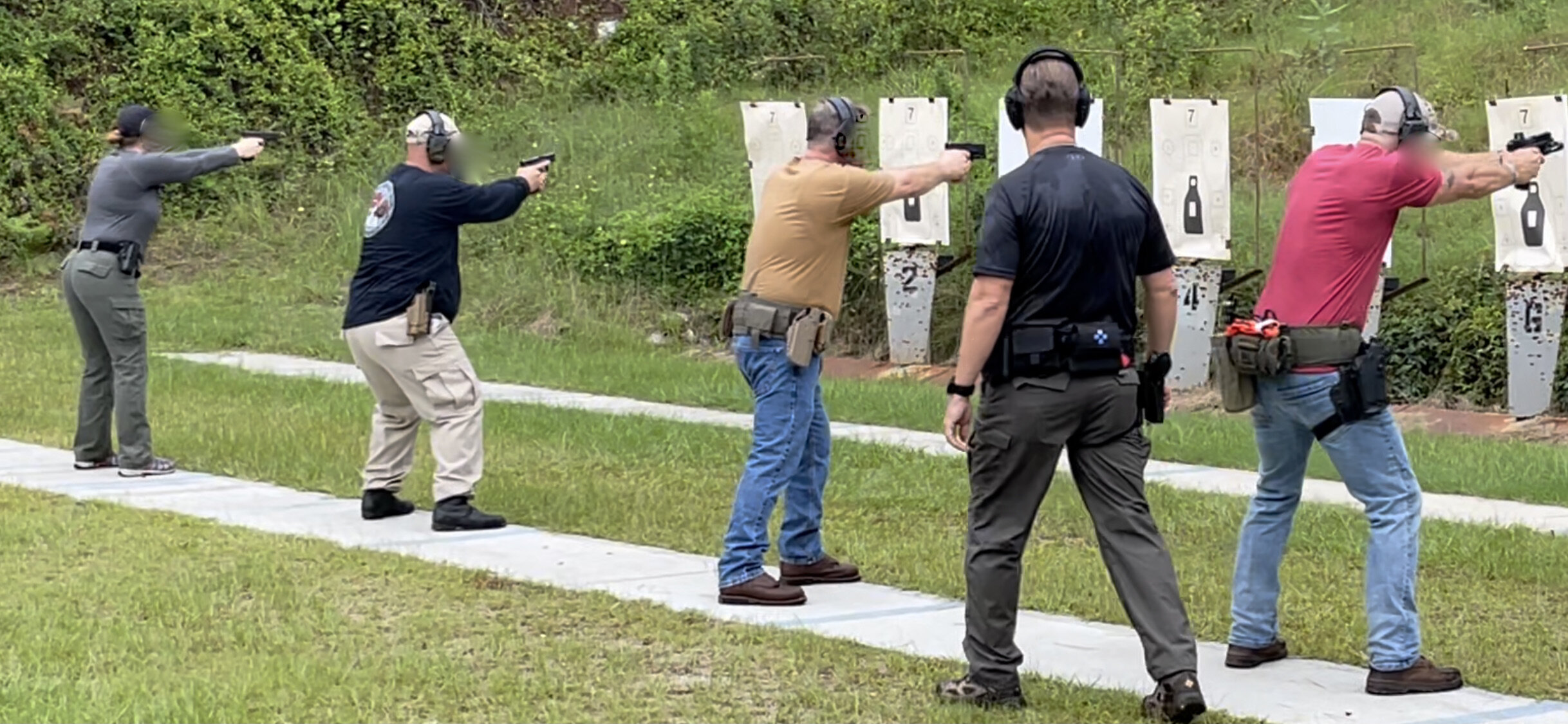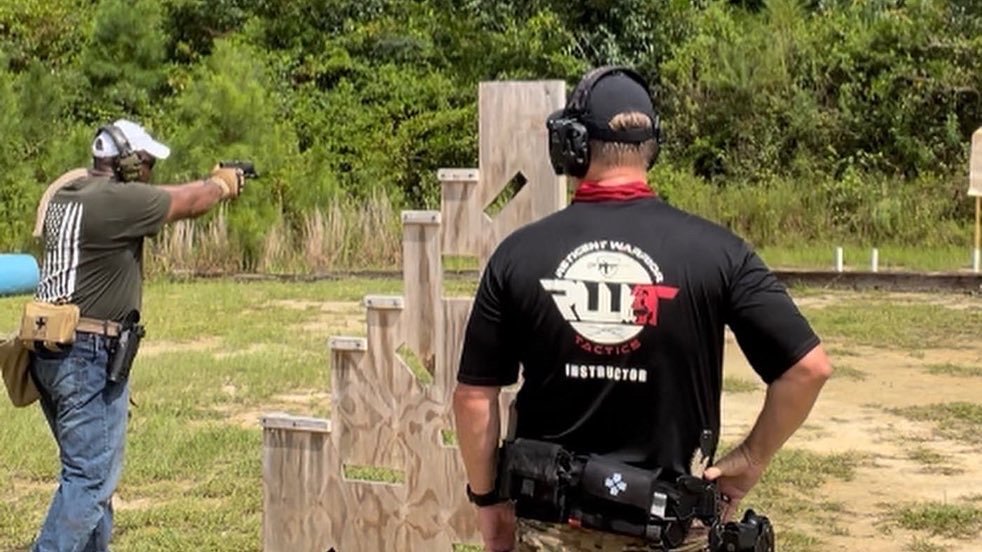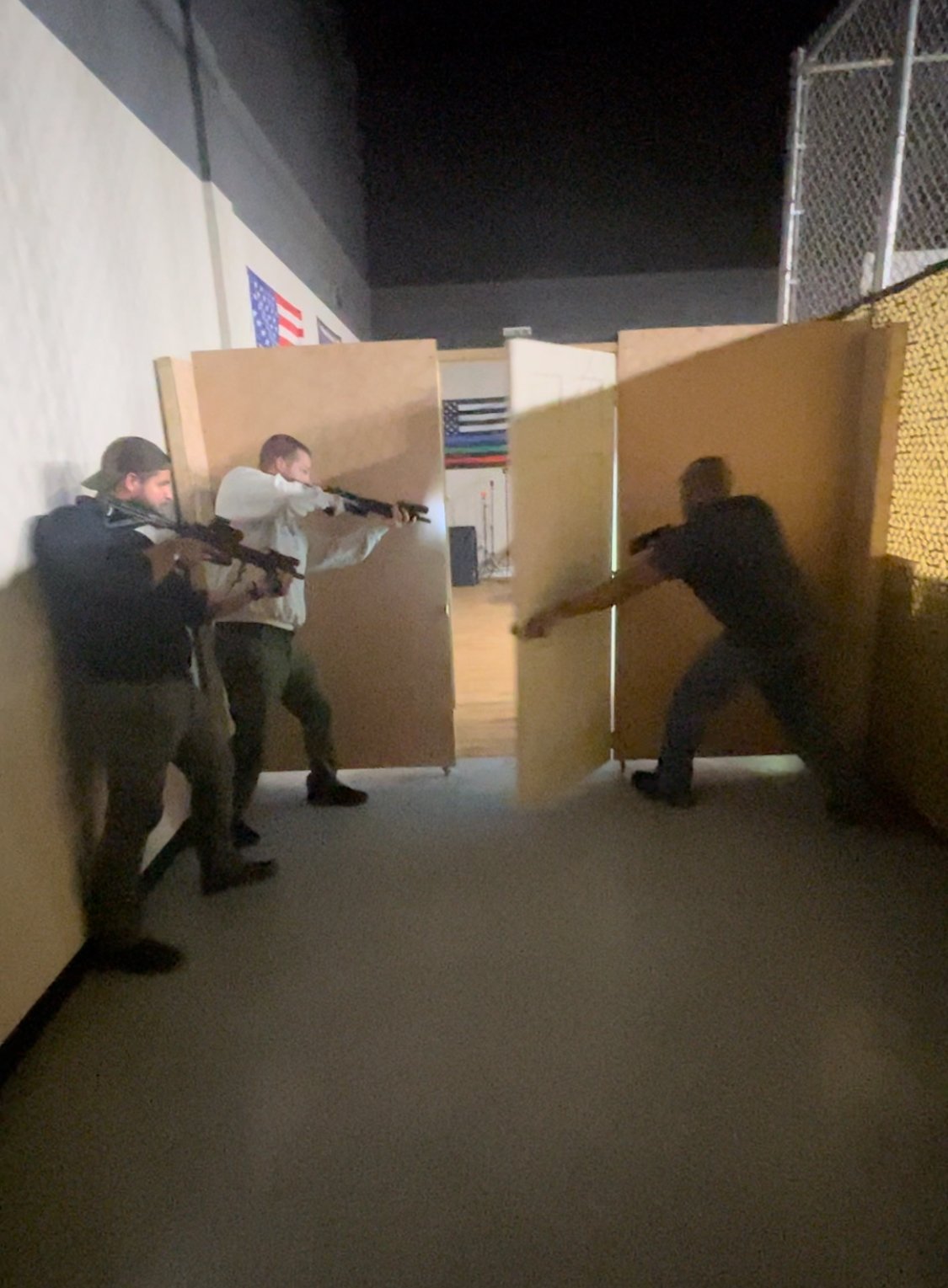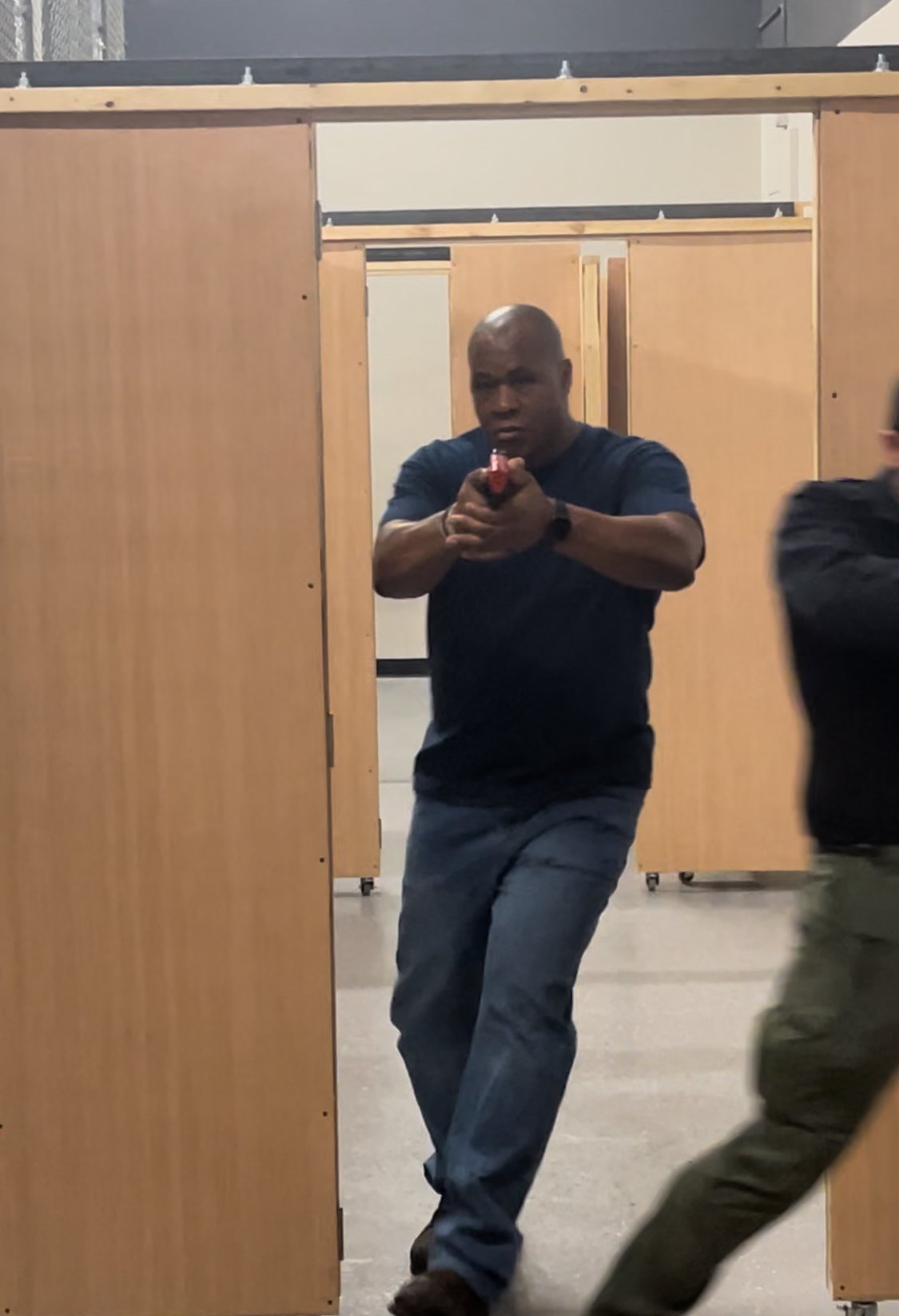Resources
Safety Rules/Marksmanship/BC/CQC and Firearms Terminology/Houses of Worship
4 UNIVERSAL FIREARMS SAFETY RULES
Treat all firearms as if they are loaded.
Never point your firearm at anything you are not willing to kill or destroy.
Keep your finger off the trigger until your weapon is on target and the decision to shoot has been made.
Know your target and what is beyond, beside and in front of it.






Fundamentals of Marksmanship
Stance - build your shooting/fighting stance from the ground up. Stand like you are about to do an athletic activity because you are.
Grip - high on the back-strap. You live or die with the grip you draw from the holster when seconds count.
Sight Alignment - simply lining up the front and rear sights with equal spacing all around.
Sight Picture - your sights aligned over your target
Breath Control - unless you are a sniper, breath normally and keep calm.
Trigger Squeeze - pressing your trigger to the rear without disrupting your sight alignment.
Follow Through - staying on target, reseting and prepping for the next shot after the first one breaks.






BC/CQC and Firearms Terminology
BC (Behavior Compliant) human actions that fall within the expected norm or human response
Behavior - activities in response to external or internal stimuli, including objectively observable activities, introspectively observable activities and nonconscious processes
Behavior baseline - a steady state of behavior against which the effects of introducing an independent variable or stimulus may be compared
Combat Stress Reaction (CSR) - any psychological reaction, ranging from mild to severe, to traumatic events in high threat environments
CQC (Close Quarters Combat) - building and room clearing using specific tactics, strategies and techniques
Empirically validated - the degree to which the accuracy of a test, model, or other construct can be demonstrated through experimentation and systematic observation
Scientific method - a set of procedures, guidelines, assumptions, and attitudes required for the organized and systematic collection, interpretation, and verification of data and the discovery of reproducible evidence, enabling laws and principles to be stated or modified
Priority of Life - the order of priority given to hostages, innocents, officers/soldiers and suspects when planning and conducting CQC
Priority of threats - the order of priority given to people, areas and openings
Reticent - restrained, reserved or quiet in nature
Warrior - one who is highly trained, highly skilled and prepared for battle
Warrior mindset - a strong mind that is prepared mentally, physically and spiritually to face death
Warrior attitude - strong love of others, ready to serve, willing to sacrifice, not willing to quit and at peace with your own death
Tactics - planned action to achieve a specific end or result
Strategy - plan of action to achieve an overall goal
Skill - personal ability to perform a specific task
Principle - fundamental truth or proposition that serves as the foundation for a system of belief or behavior or for a chain of reasoning
T.T.P. - tactics, techniques and procedures
P.A.C.E. - primary, alternate, contengency and emergency plans
Violence of Action - aggressive movement and weapon deployment that overwhelms a threat
Clearing from outside - pivoting off the apex of a door frame or corner while slicing or sweeping to clear the majority of a room or structure prior to making physical entry
Cover - any barrier that stops bullets
Concealment - hides you from view but does not stop bullets
Flagging - giving away your position by exposing any part of your body or weapon to the threat
Fighting stance - hands up with body in an athletic position with knees slightly bent, ready for action
Tactical Position - your exact location in a dwelling or structure during CQC
Tactical Accuracy - shooting that hits the general center mass area of the target quickly
Lasering - unintentionally/unknowingly pointing your weapon at another person or team member
NPA (Natural Point of Aim) - having your body and weapon aligned on target with little muscular effort
Center fed - a room with the entry door in the center of one wall
Corner fed - a room with the entry door in the corner of one wall
Deep corner - the corner in a room farthest from the door on the same wall. Typically a good hiding place.
Shallow corner - the corner in a room closet to the door on the same wall. Typically too small for a person to hide
Triggering the next angle - exposing a portion of your body or weapon to the threat while slicing or sweeping
Over penetration - going so far into a room that you unintentionally trigger the next angle
50/50 - driving directly toward a threat where you each have a 50% chance of winning the gunfight
45° angle - the first primary angle in CQC when clearing a room from outside the doorway
90° angle - typically the center of the room in CQC when clearing from outside the doorway
135° angle - the third primary angle in CQC when clearing a room from outside a doorway
180° - one complete half or side of a circle
360° - one complete circle or the entire area
Snapping - a quick concise movement taking an angle in CQC or the quick concise manipulation of a weapon
Breaching - manual, mechanical, ballistic, explosive or exothermic methods of forcing open a door or entry point
Apex - the outside edge of a door, window or corner in a structure that you are clearing around
Extracting Angles - working the angles of a room prior to making entry or corner prior to passing it
Slicing - similar to extracting angles. Taking or slicing one small piece of a room or structure at a time.
Sweep - a quick slicing of a room prior to entry usually done from a wider angle
Quick Peek - Quickly looking into a room to get a flash picture of what is inside
Push - when all team members push into a room during CQC to overwhelm a target
Button hook - entering a room by stepping around the threshold to the same side of the doorway inside the room
Cross - entering a room by crossing at an angle from one side of the door across the threshold to the other inside the room
Limited penetration - partially wrapping around a threshold, doorway or window enough to cover threats inside a room without making entry
Team leader - designated team member about 5th in the stack that helps direct team movement and direction
Point man - number one man in a team stack
Rear guard - farthest rear team member who is responsible for rear security of the team
Stepping Center - moving to the center of a threshold or doorway just prior to entry
Stepping through - stepping completely through a threshold or doorway as you break cover/concealment
Drop step - stepping back just before launching forward
Dynamic - sudden/fast entry into a structure or room
Deliberate - Slow methodical movement through a structure or room clearing as you go
AOR (Area of Responsibility) - the specific area you are responsible for during CQC
Point of Domination - a point deep enough into a room that allows you to see and control the room
Fields of Fire - individual team members areas of responsibility to address threats.
Cross cover - covering the opposite side of a hallway due to having a better angle and view of threats
Diamond formation - a team of four shooters assembled and moving in a diamond shape with each covering their side of the diamond
Muzzle First - placing the muzzle of your weapon in front of other team members prior to engaging a threat also referred to as earning the shot
Low Ready - having your weapon pointed downward below your line of sight
High Ready - having your weapon pointed upward at or below your line of sight
SUL - having your weapon pointed straight down
Temple Index - pointing your weapon straight up beside your temple. Typically used with a handgun.
Compressed Low Ready - weapon pulled in close to your body while pointed downward
Compressed High Ready - weapon pulled in close to your body while pointed upward
Retention - weapon pulled into your strong side under arm area for greater control
High/Low - shooting position with one operator standing and one kneeling
Footwork - the movement of your feet during CQC to assist in body alignment, movement and to prevent flagging
Shoulder Check - quickly looking behind you over your shoulder. Used frequently in One-Man CQC
Threat Focused - staring at the threat intently and losing sight of your surroundings similar to tunnel vision.
Scanning - moving your head, eyes and weapon together as you look for threats
Auditory Exclusion - temporary hearing loss or dulled hearing due to high stress from a threat
Tunnel Vision - temporary constriction or narrowly focused vision on one small area loosing peripheral vision
Fight/Flight/Freeze - a pattern of physiological changes elicited by activity of the sympathetic nervous system in response to threatening or otherwise stressful situations that leads to mobilization of energy for physical activity either directly or by inhibiting physiological activity that does not contribute to energy mobilizationthe body’s natural response causing one to fight, run or freeze in the presence of danger
CNS (Central Nervous System) - the processing centre of the body consisting of the brain and spinal cord
Sympathetic Nervous System - controls automatic body functions, breathing, heartbeat, etc.
Para Sympathetic Nervous System - helps return the body calm, heal and return to homeostasis
Human nature - the general psychological characteristics, feelings, and behavioral traits of humankind, regarded as shared by all humans
Psychology - the study of the mind and behavior traits, attitudes, and so forth that characterize an individual
Physiology - the science of the functions of organisms (humans), including the chemical and physical processes involved and the activities of the cells, tissues, and organs
Myelination - how neural pathways create faster highways to transmit electrical impulses
Conscious memory - where declarative (facts) and episodic (life events) are stored
Unconscious memory - where procedural (skills) are stored
Unconscious incompetence - you don’t know that you don’t know
Conscious incompetence - you know that you don’t know
Conscious competence - you know you know but have to think through it
Unconscious competence - you know it so well, you don’t even think about it
Kinesthetics - awareness of the position and movement of body parts
Economy of motion - the process of minimizing the physical and perceptual loads imposed on you while engaged in any type of work or physical activity
Hebbs’ law - Study by Dr. Donald Hebb indicating that neurons that fire together wire together.
Hicks law - (also known as the Hick/Hyman law) in experiments or tasks involving choice reaction time, the finding that the time required to classify a stimulus as being from a particular set increases proportionally with the number of stimuli in the set.
Heuristics - Any approach to problem solving or self-discovery that involves practical method that is not necessarily optimal, perfect or rational but is nevertheless sufficient for reaching a short-term goal.
OODA Loop - the decision to action process of observe, orient, decide and act
Cognitive pause - the momentary switching or changing of thought patterns brought on by a person’s OODA loop being disrupted
Proprioception - the sense of body movement and position, resulting from stimulation of proprioceptors in the muscles, tendons, and joints and of vestibular receptors in the inner ear. Proprioception enables the body to determine its spatial orientation without visual clues and to maintain postural stability
Intuition – Awareness without conscious attention. Making a rapid decision based on a limited number of facts
Perception – Becoming aware of something through your senses: seeing, hearing, touching, tasting, and smelling
Instinct - an innate tendency to act in ways that are essential to your survival
Flinch Response - the body’s natural response to a close proxemity threat
Flinch Out - using the body’s natural response to move away from a threat
Multitasking - doing muliple complex tasks at the same time which is not actually possible in CQC
Task switching - rapidly switching between complex tasks
Finding work - taking the initiative and assuming the responsibility to cover or clear a person, place or area
Index point or touch point – place on your body or gear that allows shooter to repeat a technique with precision
Direct Exposure – being exposed to a threat area without any cover or concealment
Indirect Exposure – limited exposure to a threat area from behind cover or concealment
Partial Exposure - exposing any part of your body or weapon to the threat
Down range - anyone forward of the firing line
Lasering - unintentionally pointing your weapon or muzzle at others
Emergency reload – slide is locked to the rear because the weapon is empty
Tactical reload – removing partially used mag and replacing it with a full mag
Weapon Malfunctions – failure to fire, failure to feed, failure to extract and failure to eject
Stove pipe – empty casing stuck in ejection port generally sticking up or out.
Double feed – empty casing did not extract and a second live round in now behind it
Mortaring a rifle – collapsing butt stock, pulling on charging handle as you drive butt stock into thigh or ground to clear a malfunction especially a bolt override
Double arm rowing a rifle – sitting on ground, placing rifle horizontal on ground with butt stock between your legs, hold front of rifle with both feet and then pull charging handle back with both hands in a rowing motion
Kickstarting a rifle – collapse butt stock, place rifle butt on ground pointed away from body/head, use foot on charging handle to pull it back. Least favorite, can bend charging handle
D.O.P.E. - Data On Previous Engagements. This is a term frequently used by snipers and other precision shooters. We use it in shooting drills to establish a baseline of performance.
Baseline - This is specific to the individual shooter and is a sum of their previous training and experience. Baseline in our training often refers to a General or Specific standard of performance.
Ballistics - Bullet begins to drop or fall as soon as it leaves the barrel (gravity is the number one force on a bullet). This is compensated for by having the plain of the barrel slightly elevated over the sight plain so bullet is fired up. Because of this the bullet is rising over the sight plain when first fired. 50 yard zero bullet will be rising through 50 and fall back down to the line of sight at about 200 yards. Wind has the second largest impact on a bullet’s travel and temperature is third. For every 20 degrees rise in temperature, you gain one minute of angle.
Minute of angle - The relationship between the bore, sight and/or optic is measured in minutes of angle.One minute of angle is roughly 1 inch at 100 yards.A circle is 360 degrees.One degree of a circle has 60 increments and one increment equals one minute of angle which goes to infinity.A unit of angle or unit of measure is 1 inch at 100 yards.One click on your optic is typically ½ minute or 1/3 minute of angle depending on the brand of optic
Rifle cycle of operation (8 steps)
1. Firing – failure to fire, human induced, bad ammo, broken firing pin, broken hammer spring.
2. Unlocking – few problems
3. Extracting – failure to extract, human induced, ammo casing swollen, obstruction in throat, broken or dirty extractor.
4. Ejecting – brass barely coming out. Broken ejector spring
5. Cocking – failure to cock, losing gas through gas rings or gas keys. Gas block loose.
6. Feeding – failure to feed, bad magazine
7. Chambering – failure to chamber, obstruction in chamber.
8. Locking – In battery, ready to fire.




Houses of Worship
Ministry
There are many layers to a solid church security plan or active shooter response plan. First and foremost, each member of the team must be ministered and attended to like all other members of the congregation. Your church should have a security ministry not just a team. Fellowship, prayer and scripture should be the underpinnings that support your team members. Burnout can become a real issue for those volunteering and sacrificing for the benefit of others.
Insurance
You must care for and help protect the members of your team not only spiritually, but also financially. If they shoot a suspect in protection of the church congregation, they will likely be sued and opened up to criminal liability as well. Obtain Liability Insurance coverage for the church and the active members of the team. There are many insurance options available on the open market and some that are specific to being a concealed carrier of a firearm. Some provide insurance only and others provide access to an attorney. Whatever your church chooses, your team members, their families and the church itself must be protected from catastrophic financial loss due to civil and/or criminal cases being brought after responding to a critical event such as an active shooter/killer.
Developing the plan
The church must develop an actual Security Plan/Manual (in writing). It does not have to be a 100 page in-depth answer for what to do in every situation, but it should provide sound and uniform guidance in your team’s response. Some will worry that having a plan opens the church up to liability. In actuality, the church will have a heavy liability burden if an active shooter shows up and the liability will be worse if there is no plan!!! It should involve every employee and volunteer who works at the church. It’s crucial everyone have “buy-in” to the church’s plan to protect the flock. Ingress/Egress Control is a critical component to any church security plan and must address access to the building(s), sanctuary, childcare or children’s area, bible study classrooms, etc.
Team Selection
This is one of the most difficult and important tasks. Everything, including your Active Shooter Team rises and/or falls on its leadership. Selecting the right person(s) to oversee the team is critical to success. While the team can fall under an employee or leader of the church for funding and administrative issues, it should be run by someone with the training and experience to help facilitate planning, training and response. A current of former Police Officer will likely understand this role and the role of the team better than most. They don’t have to be a trainer or instructor, but should be able to help arrange and encourage members to train.
All current and new team members MUST be trained in Active Shooter Response and Firearms qualifications. They must understand and be trained in solo and small unit tactics so they can effectively respond and end the threat. Training should be an ongoing process after their initial onboarding training to get them qualified for the team. Each member must be able to shoot a set standard with their firearm under time limits.
Biblical Authority
A church must be an open and very welcoming place to reach those in need. It also must be a “safe” place especially for those who cannot protect themselves such as children and the elderly. Members of your congregation may have questions and/or concerns about establishing an Active Shooter Team or Security Team. Helping them to understand the church’s biblical responsibility and authority to protect the flock will help calm fears and concerns.
Psalm 82:4 “Rescue the weak and needy; Deliver them out of the hand of the wicked.” Victims of an Active Shooter (AS) will be wounded, weak and needy. The AS is clearly wicked and committing murder against God’s Commandments (Deuteronomy 5:17 and Exodus 20:13 “You shall not murder.”
Nehemiah 4:9 (NIV): "But we prayed to our God and posted a guard day and night to meet this threat." It is not enough to just pray. As Christians and protectors, we must take action to accomplish the work God has set before us.
Matthew 6:9 “Blessed are the peacemakers for they shall be called sons of God.” The ultimate goal for the team is to “prevent” bad things from happening thereby keeping the peace.
Matthew 10:16 “Behold, I send you out as sheep in the midst of wolves. Therefore, be wise as serpents and harmless as doves.”
Proverbs 22:3 “The prudent sees the evil and hides himself. But the naïve go and are punished for it.”
Acts 20:28-31 “Be on guard for yourselves and for all the flock among which the Holy Spirit has made you overseers to shepherd.” Shepards guarded the flock and protected it from wolves.
John 15:13 “Greater love has no one than this, that someone lay down his life for his friends.” This powerful biblical truth could very well describe the difficult choices AS team members will face. Their souls must be ready to meet our Lord.
Luke 11:21 “When a strong man fully armed guards his own house, his possessions are undisturbed.” Jesus assumes the use of force for self-defense.
Responding to an Active Shooter
The primary goal of Active Shooter response is to Stop The Killing and then Stop The Dying in that order. Studies reveal that once the shooting starts, there is a casualty every 10 seconds so Time=Life. Doing the right thing too late is in fact the wrong thing!
Response to an Active Shooter differs based on whether or not there is a “driving force” such as gunshots, screams, etc. that provides the shooters location. Understanding the difference between a “driving force” response and a response without a “driving force” is critical for team members.
All response decisions must be made using Tactical Priorities and those start with The Priority of Life. Protecting hostages/innocents is the primary goal of any active shooter team. That means putting the lives of your flock over the lives of those responding.
Responders must pass by critically injured or even dying victims in order to stop the killing. They may drop medical gear to victims as they pass by if time permits but they cannot stop and tend to the wounded.
Once the shooter is no longer a threat, the next step is to Stop The Dying and that begins with basic medical training. We teach Stop the Bleed courses that deal specifically with direct pressure, wound packing and the proper use/placement of tourniquets. This is critically important training for all team members and church staff.
Feel free to call us with any questions about our programs or guidance with starting or improving your own church security. (912) 521-7230


